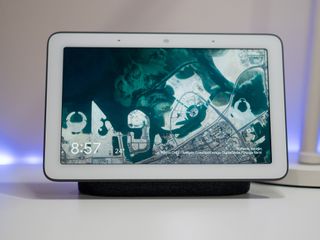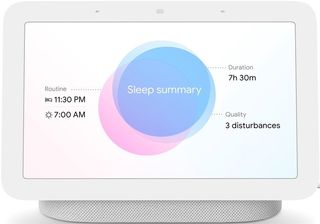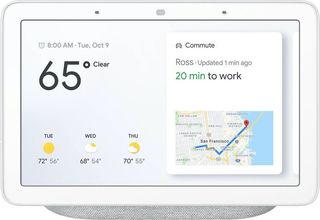Nest Hub (2nd Gen) vs. Nest Hub: Should you upgrade?

Nest Hub (2nd Gen)

The flashy new addition to the 2021 Nest Hub is its Soli radar, which has been optimized to track and rate your sleep patterns to help you get more rest. Otherwise, it has a faster CPU and some other small improvements but still lacks a video camera.
Nest Hub (2nd Gen)
Built for the bedroom
Nest Hub (1st Gen)

Unless you find the original Nest Hub at a steep discount, it doesn't offer anything the newer model lacks and probably isn't worth buying fresh in 2021. But if you already own one, it's not as far behind the 2nd-generation model in specs and features as you might think.
Nest Hub (1st Gen)
Still functional
With the new Google Nest Hub shipping on March 30, owners of the current Nest Hub — or the Google Home Hub, as it used to be called — will wonder whether or not it's worth upgrading to the new model. New buyers, meanwhile, will ask if the 2nd Gen model has enough upgrades to make it worth paying extra. The two Nest Hubs are actually pretty similar, so we'll break down the main Nest Hub 2nd Gen vs. 1st Gen differences and help you decide.
Nest Hub 2nd Gen vs. 1st Gen Specs
The two Nest Hubs are remarkably similar in appearance and built-in tech. They're certainly not identical, but current Nest Hub owners need to know that it will look much like their current model does, even if there are important feature differences. You can look at the key similarities and differences in our spec comparison table below:
| Header Cell - Column 0 | Nest Hub (2nd Gen) | Nest Hub (1st Gen) |
|---|---|---|
| Price | $100 | $90 |
| Colors | Chalk, Charcoal, Sand, Mist | Chalk, Charcoal, Sand |
| Voice assistant | Google Assistant | Google Assistant |
| Display | 7-inch LCD touchscreen (1024x600) | 7-inch LCD touchscreen (1024x600) |
| Dimensions | 4.7"Hx7.0"Wx2.7"D, 19.7 oz) | 4.65"Hx7.0"Wx2.65"D, 17oz |
| Far-field microphones | 3 | 2 |
| Mic privacy switch | ✔ | ✔ |
| Video camera | None | None |
| Speaker | 1.7-inch full-range driver | 1.7-inch full-range driver |
| Soli sleep tracking | ✔ | 🚫 |
| Soli gesture controls | ✔ | 🚫 |
| Ambient EQ | ✔ | ✔ |
| Bluetooth | 5.0 | 5.0 |
| Wi-Fi | 802.11b/g/n/ac (2.4 GHz/5 GHz) | 802.11b/g/n/ac (2.4 GHz/5 GHz) |
| Processor | Quad-core 64-bit 1.9 GHz ARM CPU | AMLogic S905D2 |
The Nest Hub (2nd Gen) has a new Mist color and is barely heavier than its predecessor, but otherwise, it's practically the same size with the same HD LCD touchscreen display as before. To be fair, Google did make the new Nest Hub with 54% recycled plastic, so you'll feel more eco-friendly for buying it.
Neither Nest Hub has a video camera, which guarantees a certain level of privacy but also prevents video calls or Google's Face Match tech, both of which you can get on the much-pricier Nest Hub Max. We'll also note that the comparably-priced Echo Show 8 does have a 1MP camera, which does enable video calls but doesn't give you great quality. Whether you see this absence as a disappointment or a relief will vary from buyer to buyer.
You get the same Wi-Fi and Bluetooth tech between the two smart displays, so either device will connect to your router or mobile devices equally quickly. The main difference here is that the new Nest Hub has an upgraded CPU with a "high-performance ML hardware engine." We can't say how much faster the new Nest Hub is for processing voice commands until we complete our review, but you can at least be sure it is faster.
Be an expert in 5 minutes
Get the latest news from Android Central, your trusted companion in the world of Android
Similarly, the audio quality of the two Nest Hubs appears to be identical on the surface: both have one 1.7-inch tweeter with no woofers or other drivers. Yet Google built a larger reservoir around the tweeter in the new device, which it claims will equate to a 50% improvement in bass quality. Neither has the audible power of the Nest Audio with its 2.95-inch woofer and 0.75-inch tweeter. However, we can't officially rate the Nest Hub (2nd Gen) for audio quality until the review.
The other main difference between the Nest Hub (2nd Gen) versus the original is that it added a third far-field microphone, which makes it more likely to properly pick up your voice across a room. Otherwise, most of the changes for the new device come down to the Soli sensors and some new software features.
Nest Hub 2nd Gen vs. 1st Gen New features

Most people use the best smart displays in the living room, where you can easily access information during your day. Most people wouldn't think to put one in a bedroom, as having a device watching or listening to you there might feel weird. But based on the new Nest Hub (2nd Gen) features — and its lack of camera — it's clear that Google intends for it to be placed in the bedroom.
Using a combination of its Soli Motion Sense radar, microphones, ambient light sensor, and temperature sensor, the Nest Hub (2nd Gen) can track your sleep patterns throughout a night and tell you how efficiently you slept, based on snores, restlessness, or other factors. Audio data is processed on the device, meaning no one at Google will hear your snoring, and then you're sent advice on how to improve your sleep on the Google Fit app. You'll eventually need to pay for Google's Sleep Sensing subscription service, but it's free until 2022.
The Nest Hub (2nd Gen) dims automatically to match the ambient lighting around it, so it won't keep you awake at night — though the original Nest Hub has Ambient EQ as well. Both Nest Hubs also have the new Sunrise Alarm, which gradually brightens the display and amplifies the alarm sounds until you're naturally awoken. What's new is that with the Soli radar activated, the Nest Hub (2nd Gen) allows you to use quick gesture controls, allowing you to (for example) snooze the Sunrise Alarm with a quick gesture and catch some more sleep.
Nest Hub 2nd Gen vs. 1st Gen: Should you upgrade?

If you're considering buying a Nest Hub for the first time, there's no doubt that the Nest Hub (2nd Gen) is the model to buy. Even if you don't plan on using the new sleep tracking tech, you'll want quality-of-life improvements like faster Google Assistant response time, extra microphone, gesture controls, and more resonant bass. Especially since at present the new model only costs $10 more.
The more tricky question is whether current Nest Hub owners should buy it. If you live in a larger home and need a separate display for both the living room and bedroom, the new smart display would fit a different niche. But for a new living room display, the upgrades are minor enough that it may not be worth it. Google is still updating the original Nest Hub with new features, so it's not as though it's obsolete.
The true upgrade purchase for a Google smart display is the Nest Hub Max, but that will cost you more than twice the price in exchange for a video camera, larger speakers, and Soli tech that doesn't have sleep tracking. The Nest Hub (2nd Gen) may not be as dramatic an upgrade by comparison, but at least it won't break the bank.

Faster, clearer voice commands
Looking to buy a Google smart display without paying twice the price for the Nest Hub Max? The Nest Hub (2nd Gen) is the clear choice. It has some small but significant upgrades that make it more responsive whichever room it's in, but it's optimized for folks that want Google Assistant helping them to get better sleep or answering questions in the bedroom.

Save a bit of cash
We don't necessarily recommend you purchase the original Nest Hub, not compared to its successor. But if you currently own it, it still could be considered one of the best smart displays in its price range, and should still answer any questions you may have!

Michael is Android Central's resident expert on fitness tech and wearables, with an enthusiast's love of VR tech on the side. After years freelancing for Techradar, Wareable, Windows Central, Digital Trends, and other sites on a variety of tech topics, AC has given him the chance to really dive into the topics he's passionate about. He's also a semi-reformed Apple-to-Android user who loves D&D, Star Wars, and Lord of the Rings.
For wearables, Michael has tested dozens of smartwatches from Garmin, Fitbit, Samsung, Apple, COROS, Polar, Amazfit, and other brands, and will always focus on recommending the best product over the best brand. He's also completed marathons like NYC, SF, Marine Corps, Big Sur, and California International — though he's still trying to break that 4-hour barrier.
